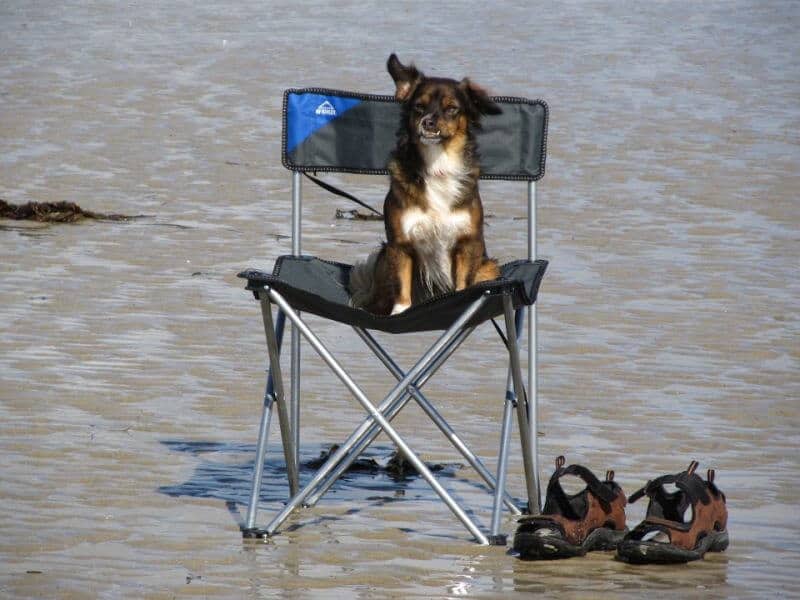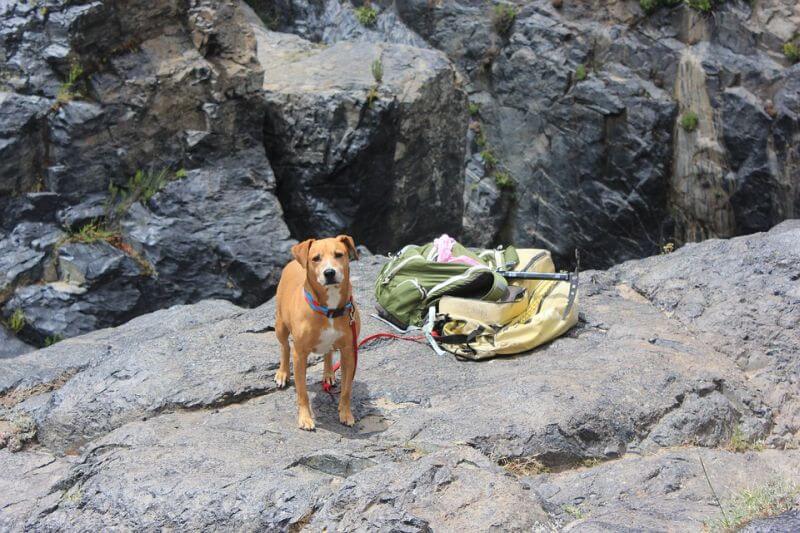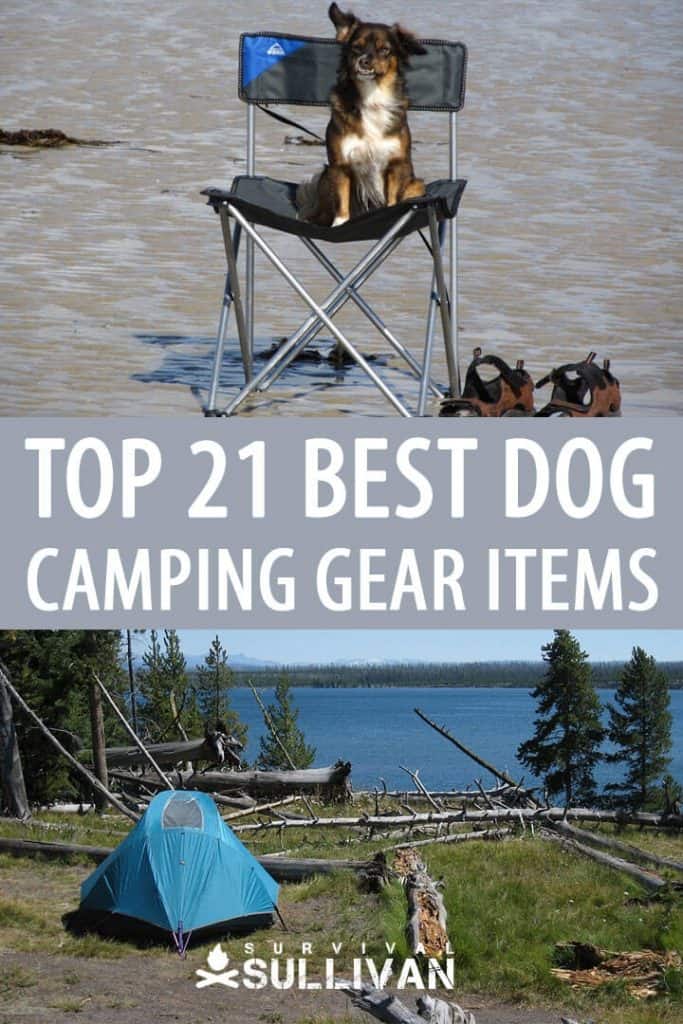Taking along camping items for your dog has a two-fold purpose – it makes the dog’s trip more comfortable and your own trip hassle free so you can enjoy exploring the outdoors together without glitches.
The food your dog eats is not on this list – just make sure you don’t forget that very important item.

1. Temporary Tag
The dog should be micro-chipped enabling the animal to be returned to you, and the dog probably already has an ID tag giving your telephone number and home address, but is a good idea to have a little temporary ID tag giving the name of your camp and site number as well as your cell phone number and the phone number of the nearest ranger station in case there isn’t good cellphone coverage at your site.
Should the dog get lost it can be returned to your campsite. People often give up looking for the owner if they think the dog is too far from home. A few luminous write-on dog tags will help get your pup back to camp.
2. Short leash and longer leash
Keep your dog on a short leash. They come in various sizes so you can choose how close you want your pet to be – 8 inches, 12, 18, or 30 inches if you are walking in thickly forested areas.
A short leash avoids the dog getting the leash tangled around trees and if you are hiking in canyon country you don’t want the dog dashing off and perhaps falling down a slope.
The longer leashes that vary from 15 foot to 20 foot right up to 100 foot can be used when you are on open ground and near water so the dog can enjoy a bit more freedom in safety, or even if you need to keep the dog tethered around the campsite.
If your dog needs better control than on a collar and leash then a harness is comfortable and durable for all day adventure hiking.
Unless you know the area well don’t let the dog loose on hikes in case the dog goes off exploring and comes across snakes or other dangerous creatures like bears. Dogs are also notorious for scrabbling down an embankment to the water’s edge and then battle to get up again.
3. A life jacket for dogs
Disclosure: This post has links to 3rd party websites, so I may get a commission if you buy through those links. Survival Sullivan is a participant in the Amazon Services LLC Associates Program. As an Amazon Associate, I earn from qualifying purchases. See my full disclosure for more.
My Labrador got caught in a river current and had to swim very determinedly to get back to shore much further downstream and was quite tired. I wish I’d had a float coat with its bright yellow reflective material. It is also adjustable to suit various sizes.
Then my staffie, who was convinced she was Superdog attempted to swim across a very wide river mouth with us instead of staying with the rest of the family on the beach.
She got tired half way – so we had to support her the rest of the way. A life jacket would have been perfect – allowing her to retain her illusions!
4. Dog bed
There are a variety of beds for dogs. In warmer weather they will appreciate the foldaway dog bed that elevates them 6 inches off the ground so they get maximum airflow to keep them cool.
It folds up like a camp chair and is very convenient and comes in various sizes to accommodate even large dogs. It also keeps them off damp and cool ground in colder weather.
The folding pet bed from Carlson Pet Products is waterproof and can be hosed down to clean it – it is also quick drying and at 46” long will accommodate large breeds of dog up to 95 pounds. The pet bed for smaller dogs is 26” long. In cooler weather you’ll need to add other pet bedding.
The Canine Chuckit Travel Bed is 30 x 39 inches and suited to medium and larger dogs. It’s a roll-up-and-go bed with a washable poly suede surface. You’ll know whether your dog likes to stretch out when sleeping or prefers to curl up so select a suitable bed size accordingly.
5. Camp pads
Cut down an old camp pad to put beneath a pet bed if you don’t go for an elevated bed. It will keep the chill from the ground rising through the dog’s bedding at night. In the day you can put the camp pad outside with the machine washable reversible pet bedding so the dog knows where to find its safe rest area.
But of course there are innovations like the Cooling pressure activated mat designed for dogs who are feeling the summer heat.
In fact this may save your garden at home too when the heat gets too much and the dog selects a nice shady spot of your special plants to dig up and lie in Dogs love this mat when they’ve been out for a hike and their tongues are drooping.
6. Collapsible water and food bowls
Collapsible water and food bowls take up very little space and can go along in your backpack on a hike. You can also take lightweight stainless steel bowls, but when you are camping lightweight rigid plastic bowls are not a good idea they can split on the journey and then what does the dog drink out of?
Also remember to remove food bowls at night so you don’t attract the attention of local wild life that may want an extra snack.
7. Ball or Frisbee
Kids and dogs will have endless hours of fun at the campsite with a ball or a Frisbee, that is, if the dog isn’t too tired after a long hike.
Always make sure the dog isn’t overdoing it as they get so excited they just keep going even though they are “dog-tired”, and you may have them whimpering as they have used muscles they are not used to using and might be stiff and sore in the morning.
Rather than the average tennis ball bring along an indestructible one for the trip. Dogs will also enjoy the squeak in this one! When it comes to a Frisbee an indestructible one is best with soft edges for the dog’s mouth – and this one floats too!
8. Dog booties
You may think this is overkill but if a dog’s footpads split or rub raw on rough ground it can be hard going for them. The booties will help with protection from rocks, thorns and even insect bites from the likes of scorpions.
Also, in icy weather, the dog will appreciate having boots that are water resistant and have an anti slip sole. If your dog does not like the idea of wearing booties then get some Musher’s Secret Paw Wax to protect its feet.
9. Dog comb
In the wilderness dogs pick up seeds and burrs in their coats which can be uncomfortable. Also even if they have tick prevention medication the ticks will still crawl onto the dog before finding a better host – and you don’t want that host to be you! Use a lightweight dog comb to get rid of all these unwanted hitchhikers.
10. Tick key / tweezers
Be responsible and make sure the dog’s vaccinations for tick borne disease and heartworm etc. are up to date.
Should a tick embed itself in the dog – they usually choose the groin, armpits and ears or near the eyes, then a pair of tweezers or a special wallet-sized tick key will help remove the whole tick – too often people twist the tick off and the head gets left behind in the flesh and that causes a bit of a sore.
Grasp the tick firmly but gently so you get the whole thing out. The tick remover also comes with a tick identification card and tick testing sample it so you can send the tick away for testing for Lyme’ disease.
Don’t believe remedies like putting Vaseline on the tick or nail polish or even worse taking a lighter to the tick while it’s on the dog – you are just maybe going to set your dog on fire, or have a greasy Vaseline smeared dog that picks up all the dust possible.
11. A juicy bone or two
Not a plastic bone or a chew toy but a real honest-to-goodness large beef bone or two from the butcher will occupy your dog at the campsite so it doesn’t get under your feet when making fires and working with hot water.
It is good for their teeth, and raw bones with the marrow provide the dog with protein, calcium, fat, minerals, and hours of fun.
Never give your dog cooked bones from your stew or barbequed meat as cooked bones splinter more easily, and you don’t want to have to find the nearest emergency vet after dinner!
By the way, you should find out the name and number of the nearest emergency vet – 99% of the time your pet will have a wonderful experience camping but it’s good to be prepared for the 1% eventuality.
12. Doggy sleeping bag
When it’s really cold dogs will enjoy cuddling into a sleeping bag It may save you from having the dog trying to burrow into your sleeping bag with you!
13 Doggy face cloth
Dogs overheat because they are so active and panting is the way they cool so if you notice your dog is panting hard find some shade and do a wipe down to help with cooling off.
Pet wipes are handy to have stashed in the backpack for all sorts of eventualities like wiping eyes and cleaning ears, as well as cooling off.
14. A doggy backpack
Some people like to put a dog backpack on their pet so it can carry its own supplies. Just be careful of overloading it, and they can make the animal hot so choose one with breathable material.
Backpacks for dogs usually have a small first aid kit, treats and some water plus the collapsible bowl. The dog will have to be used to walking with a pack otherwise the hike will be miserable for the dog as it tries to rid itself of its irritating load.
You’re also going to need poop bags to collect the presents the dog leaves – even if the poop is not on the path and doesn’t pose a problem to other hikers it still contains bacteria that may not be compatible with the eco system – and many wilderness places have fragile eco systems.
15. Waist belt clip or waist belt
Although not strictly for the dog, a clip that fastens the leash to your waistband certainly gives you more freedom of movement as you have both hands free for balance when negotiating a stream crossing or going over rocky ground, step ascents or descents.
This one fastens around the owner’s waist while this one is a multi-functional leash that can be worn various ways to leave you hands free.

16. A Muzzle
Hopefully you don’t need one of these, but it’s good to have in the first aid pack which we will discuss in point #20, because if your pet does get hurt and needs treatment the muzzle will make it so much easier to control.
Also if you are worried about poisonous plants or insects the dog may eat on the trail you could use this lightweight muzzle.
17. Nail clippers
Ideally these shouldn’t be needed but if you forgot to trim the dog’s nails before you left then having nail clippers at camp will help so they don’t tear out nails on rough ground, or gouge holes in your tent floor with long nails.
Always check the back dewclaws as if they haven’t been removed, as they tend to curl round and dig into the flesh.
18. Silent dog whistle
They work on the range of sound between 5.4KHz and 12.8KHz that dogs can detect but is insignificant to humans, so you won’t be disturbing fellow hikers, but can at least let your dog know where you are in case you get separated, or call it back if its gone on a foray of its own.
19 Doggy snacks
Don’t feed your dog your trail mix or Doritos – nuts and highly salted food are not good for them. Pack their favorite treats to enjoy during breaks along the way – these Wildness Trail Treats are a crunchy option or you may prefer to reward your dog with a jerky treat.
20. Bear bells
If you are in bear country or in fact any place where the dog might scare up wild animals then bells on the collar if the animal is let loose will let you know where it is.
Bells will alert smaller animals so they can escape, and your dog won’t run the risk of coming face to face with a mother bear and her cubs with this Heavy Duty bear bell that can be attached to a dog’s collar also has a silencer which you can activate when the hike is over and you are safe in camp.
21. First Aid Kit
Build your first aid kit according to the type of terrain you’ll be camping in. Rough ground means you may need wound gel to treat sore footpads or scratches from branches and thorns. Sterile saline solutions will help if the dog gets a deep puncture wound, but for lighter scratches rubbing alcohol will do.
A wound cleanser in a spray on form will keep the wound clean and stop flies collecting on it. Kwik Stop Styptic Powder will stop bleeding on minor cuts.
Tweezers may be necessary to remove thorns, or porcupine quills. Vet Wrap doesn’t stick to the dog’s hair and will bandage a wound and keep it clean.
If your dog is susceptible to sand, dust or pollen you may need eye drops, and Labradors and spaniels particularly are susceptible to ear infections, which is really smelly if their ears remain damp after swimming!
You’ll need ear drops after they have been in the water. Tetanus is in the ground and can be found in dead animals or if the dog gets a bite from an animal – rather play it safe and get a tetanus shot before you go camping.
If a dog gets tetanus they will get muscle spasms and stiffness and it usually starts in the facial area so it will be lockjaw and the ears will be at a weird angle. Fortunately it is uncommon as dogs are fairly resistant to the toxin. Rabies vaccinations should also be up to date.
Your Dog Will Love You if You Get These
You won’t need all the items on this list – but if you want a happy camping experience for you and your pet you’ll definitely want to include quite a few of the above.

Traveler, photographer, writer. I’m eternally curious, in love with the natural world. How people can survive in harmony with nature has fueled my food safety and survival gardening practices.
At the age of 12, I found a newspaper advertisement for a 155-acre farm at a really good price and showed my parents one Sunday morning. They bought it and I happily started planting vegetables, peanuts, maize and keeping bees with the help of the local labor.
Once I married wherever we moved it was all about planting food, keeping chickens and ducks, permaculture and creating micro-climates. I learned how to build wooden cabins and outdoor furniture from pallets, and baked and cooked home-grown produce, developing recipes as I went along.

